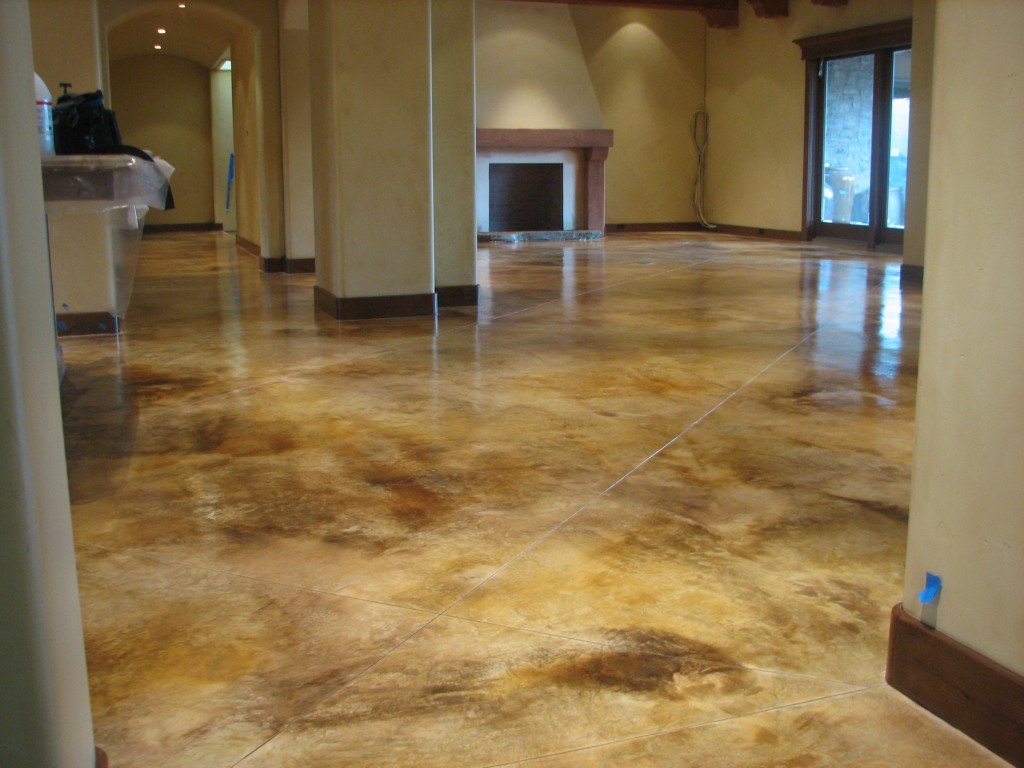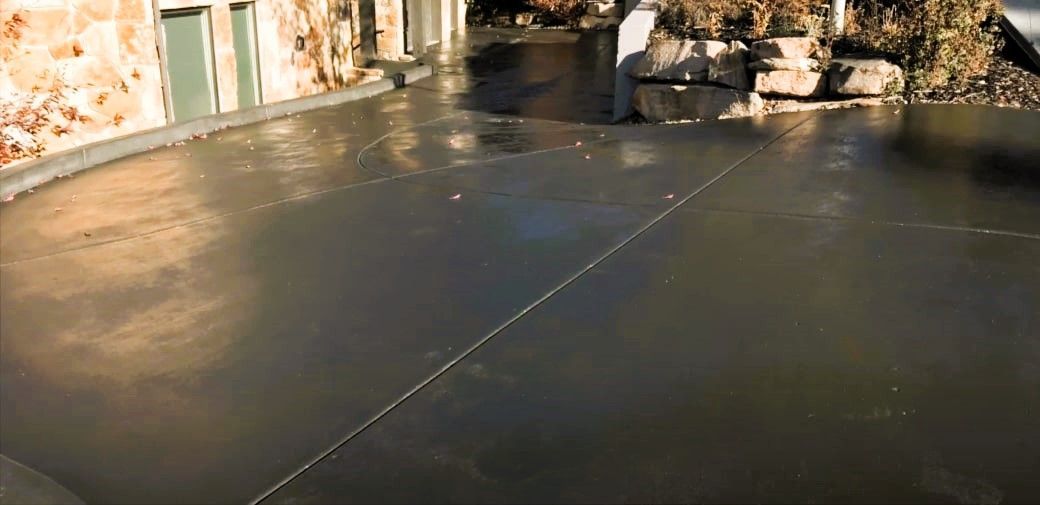The long-lasting strength of austin stained concrete floors explained
Wiki Article
Comprehending the Different Kinds Of Stained Concrete for Your Following Task
Stained concrete deals different alternatives that satisfy different aesthetic and practical requirements. Each kind provides unique attributes that influence the final appearance and sturdiness of the surface area. Comprehending these distinctions is crucial for any individual preparing a task. From rich, chemical responses of acid-based stains to the lively uniformity of strong color stains, the selections can significantly impact the result. What factors should one consider when selecting the suitable discolor for their specific needs?Introduction of Stained Concrete
Stained concrete works as a flexible flooring option that can enhance the aesthetic appeal of various rooms. This method includes using a tinting representative to the surface of existing concrete, enabling a broad range of design possibilities. Stained concrete is prominent in both household and business atmospheres, providing a sturdy and low-maintenance option that can mimic the appearance of all-natural products like stone or tile.The staining procedure can be executed using water-based or solvent-based products, each offering distinct visual impacts. The final appearance is affected by variables such as the original concrete surface, the kind of discolor made use of, and the application approach. Stained concrete not just improves interiors and outsides yet likewise advertises sustainability by renewing existing concrete frameworks. Consequently, it has actually gotten traction amongst house owners and designers looking for both performance and design in their floor covering options.
Acid-Based Stains: Attributes and Advantages

Unique Shade Variants
Concrete surfaces can transform significantly with the application of acid-based stains, which provide an abundant combination of one-of-a-kind shade variations. These stains permeate the concrete, responding chemically to produce vivid planet tones that vary from deep browns and reds to soft eco-friendlies and blues. The resulting shades are often variegated, developing an all-natural, marble-like look that boosts the concrete's character. Each application returns distinct results because of variations in the concrete's structure and the discoloration technique used, making every task distinct. Furthermore, acid-based stains can be layered or integrated with various other techniques to develop tailored designs, permitting for individual expression. This convenience makes acid-based stains a popular selection for both property and commercial applications.Chain Reaction Described
While lots of aspects add to the efficiency of acid-based stains, the underlying chemical responses play a necessary role in their one-of-a-kind qualities and benefits. These stains primarily consist of water, acid, and metallic salts. When applied to concrete, the acid responds with the calcium hydroxide in the cement, creating a chemical transformation that results in permanent color modifications. The metal salts pass through the surface area and bond with the concrete, enabling a vast array of hues and tones. This response not only improves aesthetic allure but also gives durability, making the color immune to fading and wear. Additionally, acid-based stains can develop a variegated surface that mimics natural stone, additional boosting their appeal for attractive concrete applications.Surface Area Preparation Value
Attaining perfect outcomes with acid-based stains depends upon detailed surface area prep work. This important action warranties that the concrete surface is tidy, devoid of impurities, and properly profiled for suitable stain absorption. Any kind of existing sealers, dirt, or oils can prevent the chain reaction that generates the wanted shade and surface, causing irregular or patchy results.Prior to applying the discolor, the concrete ought to be mechanically cleaned or stress cleaned, adhered to by a detailed examination for fractures or flaws that may call for repair service. Furthermore, verifying the surface is adequately dried out will improve tarnish adherence. By focusing on these preparatory steps, the durability and vibrancy of acid-based stains can be greatly enhanced, causing a much more aesthetically pleasing and sturdy coating.
Water-Based Stains: Features and Advantages

Water-based stains pass through the concrete, offering a much more clear finish that highlights the all-natural appearance and variants of the surface beneath. They are readily available in a vast variety of colors, enabling imaginative flexibility in design. Furthermore, water-based stains are much easier to clean up, calling for just water and soap, which simplifies the application process.
Their quick drying time boosts performance, making them a useful selection for both DIY enthusiasts and experts. In general, water-based stains give an appealing mix of visual flexibility and user-friendly residential or commercial properties, making them a preferred alternative for concrete improvement tasks.
Solid Shade Stains: Dynamic Options for a Strong Look
Solid shade stains use an effective option for those seeking to produce a vibrant and dynamic aesthetic on concrete surfaces. These stains supply a consistent coloration that can dramatically boost the visual charm description of floorings, patios, and driveways. Offered in a wide range of hues, strong color stains enable imaginative expression, accommodating numerous style preferences.Among the crucial benefits of solid shade stains is their capability to hide imperfections, offering a fresh and refined aim to maturing concrete - Austin Stained Concrete Floors. In addition, their solution usually includes UV-resistant residential or commercial properties, ensuring long life and shade retention even in rough climate condition
Application is straightforward, requiring minimal preparation of the concrete surface area. When applied, solid shade stains can be sealed for added security and sheen, further raising their visual quality. With their vibrant choices, solid color stains are an exceptional option for those aiming for an impactful and natural design.
Semi-Transparent Stains: Achieving Depth and Measurement
Semi-transparent stains offer a special approach to boosting concrete surface areas by giving depth and measurement through numerous shade choices. Understanding the application techniques is important for achieving the wanted result, while appropriate upkeep practices assure long life. This area will explore these essential aspects to make best use of the benefits of semi-transparent staining.Shade Options Available
A wide array of shade choices exists for semi-transparent stains, permitting property owners and designers to improve the all-natural appeal of concrete surface areas. These stains come in a range of shades, from earthy tones like browns and terracottas to vibrant colors such as blues and eco-friendlies. The semi-transparent nature of these stains enables the underlying concrete to reveal with, developing an one-of-a-kind depth and dimension that can complement numerous style appearances. Furthermore, incorporating different colors can produce personalized tones, allowing a tailored appearance for each job. This flexibility makes semi-transparent stains a preferred choice for both exterior and interior applications, as they can integrate with surrounding components while including aesthetic passion to plain concrete.Application Strategies Discussed
To achieve the desired depth and dimension with semi-transparent stains, correct application strategies are vital. Surface prep work is essential; the concrete has to be clean and free of any impurities. This usually entails power washing and repairing any kind of splits. Next off, choosing the ideal applicator, such as a sprayer, roller, or brush, can affect the final appearance. Sprayers permit a more even application, while rollers can help accomplish appearance. It is important to use the tarnish in slim, also layers, permitting each layer to dry prior to adding another. Manipulating the application strategy, such as varying pressure or making use of various devices, can develop unique results. Securing the stained surface area enhances the vibrancy of the colors while providing defense.Upkeep Finest Practices
Normal upkeep is essential for preserving the appeal and integrity of surface areas treated with semi-transparent stains. To keep these surface areas, routine cleansing is crucial. Utilizing a pH-neutral cleaner and a soft-bristle mop will certainly assist get rid of dirt and debris without damaging the discolor. It is advisable to avoid harsh chemicals, as they can degrade the stain's look. Furthermore, routine resealing every one to three years can protect versus wear and fading. This process includes cleansing the surface area completely and using a compatible sealant made for stained concrete. Home owners must likewise monitor for any type of indications of staining or damage and address these problems promptly to assure long-lasting vibrancy and resilience. my link Complying with these best practices will certainly enhance the overall lifespan of semi-transparent stained surfaces.Impacts and Methods: Customizing Your Stained Concrete
Tailoring stained concrete includes an array of strategies that improve both aesthetic appeals and performance. Amongst these techniques, layering various tarnish colors can develop depth and complexity, enabling special visual effects. Techniques such as acid discoloration give a variegated look, while water-based stains supply an extra consistent appearance.Additionally, incorporating ornamental patterns, such as stenciling or inscription, can better customize the surface, including complex layouts that cater to individual preferences. Texturing the concrete, whether via marking or broom finishes, presents responsive elements that not only enhance grasp yet additionally boost aesthetic rate of interest.
In addition, applying sealers can amplify the shade vibrancy and provide defense against wear. Modification strategies expand past simple shade; they can transform a conventional concrete slab right into a sensational prime focus, making it suitable for both property and business rooms. With careful selection of impacts and methods, stained concrete can accomplish a genuinely customized look.
Maintenance and Long Life of Stained Surfaces
Stained concrete surface areas are understood for their durability and visual appeal, maintaining their integrity is important for ensuring long life. Regular cleaning is vital; sweeping and mopping with a pH-neutral cleaner helps stop dirt buildup and discoloration. Additionally, using a sealant every few years can protect the surface area from wetness, chemicals, and UV damages, consequently boosting its life expectancy.It is additionally important to deal with any type of splits or chips without delay. Tiny repair work can minimize additional damage, preserving the aesthetic and architectural quality of the surface area. For exterior stained concrete, seasonal maintenance, such as eliminating snow and ice, is essential to stop surface area damages from freeze-thaw cycles.
Frequently Asked Concerns
Can I Tarnish Existing Concrete Surfaces or New Ones?
The inquiry of whether existing concrete surfaces can be stained develops Website often. It is without a doubt possible to stain both new and old concrete, gave the surface is sufficiently ready and totally free of pollutants for excellent attachment.The length of time Does the Staining Process Typically Take?
The staining procedure generally takes one to 3 days, depending on aspects such as surface preparation, kind of tarnish, and weather. Austin Stained Concrete Floors. Curing time may prolong beyond first application, affecting the overall period substantiallyIs Stained Concrete Safe for Outdoor Usage?
Stained concrete is generally secure for outside usage, provided it is correctly secured. This sealing secures against dampness and UV damages, making certain resilience and safety and security, while additionally improving the aesthetic allure of exterior spaces.Can I Apply Multiple Spot Layers for Different Results?
Applying several tarnish layers can accomplish diverse impacts on stained concrete. However, it is necessary to assure compatibility between stains and enable correct drying out time in between applications to stay clear of unintentional responses or staining.Exist Any Type Of Shade Limitations for Stained Concrete?
Shade constraints for stained concrete primarily depend upon the kind of discolor used, with water-based stains offering a more comprehensive combination contrasted to acid-based stains. Stained Concrete Austin. Attaining vivid shades might call for cautious option and application techniques.Report this wiki page